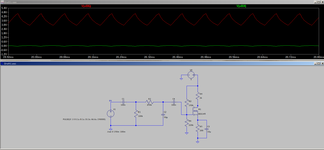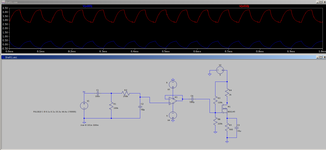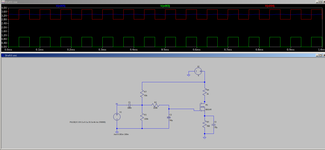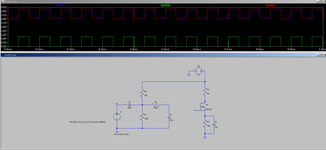I14R10
Full Member level 3
First of all, I will say I only have basics of analog electronics, so my design is probably wrong in so many places.
What I'm trying to do:
I have a square wave, but not from -V to +V, instead from 0 to V.
Next step, C1, R1 remove DC component of the signal
R2, C2 make low pass filter that gets me a triangle wave.
At this point, without the rest of the circuit to the right, I have an amplitude of around -0.4V to +0.4V at the junction of R2 and C2.
Now I want to amplify that signal with a MOSFET. MOSFET alone doesn't change my signal, but when I bias it to get a half of 5V on drain, those resistors for biasing lower the signal on the junction of R2, C2 and C4. What can I do to completely separate those two circuits so that I can bias MOSFET properly?
If I put an opamp as a buffer, things work. But let's say I don't want to use op Amps, how would I do it?
What I'm trying to do:
I have a square wave, but not from -V to +V, instead from 0 to V.
Next step, C1, R1 remove DC component of the signal
R2, C2 make low pass filter that gets me a triangle wave.
At this point, without the rest of the circuit to the right, I have an amplitude of around -0.4V to +0.4V at the junction of R2 and C2.
Now I want to amplify that signal with a MOSFET. MOSFET alone doesn't change my signal, but when I bias it to get a half of 5V on drain, those resistors for biasing lower the signal on the junction of R2, C2 and C4. What can I do to completely separate those two circuits so that I can bias MOSFET properly?
--- Updated ---
If I put an opamp as a buffer, things work. But let's say I don't want to use op Amps, how would I do it?
Attachments
Last edited:



